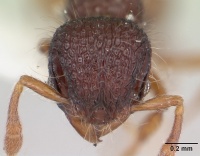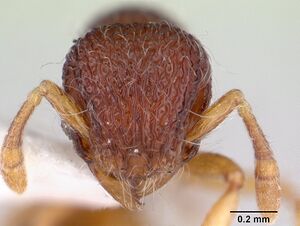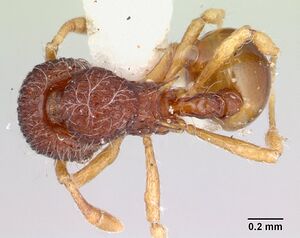Lachnomyrmex nordestinus
| Lachnomyrmex nordestinus | |
|---|---|

| |
| Scientific classification | |
| Kingdom: | Animalia |
| Phylum: | Arthropoda |
| Class: | Insecta |
| Order: | Hymenoptera |
| Family: | Formicidae |
| Subfamily: | Myrmicinae |
| Tribe: | Attini |
| Genus: | Lachnomyrmex |
| Species: | L. nordestinus |
| Binomial name | |
| Lachnomyrmex nordestinus Feitosa & Brandão, 2008 | |
All known specimens were collected in the leaf litter of the northeastern Brazilian Atlantic Forest (100–800m).
Identification
Feitosa and Brandão (2008) - Promesonotum strongly convex and elevated well above the level of propodeum, in profile; metanotal groove obsolete; apex of propodeal spines slightly curved upwards; teeth of propodeal lobes reduced; dorsum of postpetiole with around six long hairs; first gastral tergite entirely devoid of long flexuous hairs. This species is very similar to Lachnomyrmex amazonicus and Lachnomyrmex victori, but can be readily distinguished mainly by the scarcer pilosity on postpetiole dorsum. Gynes of L. nordestinus can be separated from L. victori by the absence of long flexuous hairs on the dorsum of the first gastral tergite.
Keys including this Species
Distribution
Latitudinal Distribution Pattern
Latitudinal Range: -7.14° to -10.765°.
| North Temperate |
North Subtropical |
Tropical | South Subtropical |
South Temperate |
- Source: AntMaps
Distribution based on Regional Taxon Lists
Neotropical Region: Brazil (type locality).
Distribution based on AntMaps
Distribution based on AntWeb specimens
Check data from AntWeb
Countries Occupied
| Number of countries occupied by this species based on AntWiki Regional Taxon Lists. In general, fewer countries occupied indicates a narrower range, while more countries indicates a more widespread species. |

|
Estimated Abundance
| Relative abundance based on number of AntMaps records per species (this species within the purple bar). Fewer records (to the left) indicates a less abundant/encountered species while more records (to the right) indicates more abundant/encountered species. |

|
Biology
|
Castes
Images from AntWeb
   
| |
| Paratype of Lachnomyrmex nordestinus. Worker. Specimen code casent0178857. Photographer April Nobile, uploaded by California Academy of Sciences. | Owned by CAS, San Francisco, CA, USA. |
Nomenclature
The following information is derived from Barry Bolton's Online Catalogue of the Ants of the World.
- nordestinus. Lachnomyrmex nordestinus Feitosa & Brandão, 2008: 29, figs. 11, 18 (w.q.) BRAZIL.
Unless otherwise noted the text for the remainder of this section is reported from the publication that includes the original description.
Description
Worker
Holotype measurements. HL 0.65; HW 0.65; ML 0.22; SL 0.38; EL 0.13; WL 0.72; PSL 0.19; PL 0.31; PPL 0.13; GL 0.80; TL 2.84; CI 100; SI 59; OI 19. Worker measurements (n=16). HL 0.63–0.74; HW 0.61–0.72; ML 0.20–0.24; SL 0.37–0.46; EL 0.12– 0.14; WL 0.68–0.80; PSL 0.15–0.24; PL 0.30–0.36; PPL 0.11–0.14; GL 0.77–0.93; TL 2.71–3.18; CI 96–100; SI 59–67; OI 19–22.
Color light brown to blackish, contrasting with yellowish appendages and gaster. Body densely covered by vermiculate short rugae, forming irregular areolae on promesonotum dorsum; rugae somewhat longer and longitudinal on head dorsum, and slightly sparser on mesopleura and lateral surfaces of propodeum; mandibles with short longitudinal striae restricted to basal portion; petiole and postpetiole finely and irregularly rugose. Abundant pilosity on head and promesonotum dorsum; dorsum of petiolar node and postpetiole with around 10 and six long flexuous hairs, respectively; first gastral tergite entirely devoid of long hairs. Head as long as broad to slightly longer than broad, with vertexal margin only minimally convex; frontal lobes laterally rounded; eyes with about six facets on maximum diameter. Promesonotum strongly convex in profile, elevated well above the level of propodeum; metanotal groove virtually obsolete; propodeal spines well developed and slightly directed upwards; teeth of propodeal lobes reduced, with approximately one-third of propodeal spines length. Petiolar node moderately elevated and rounded dorsally, with the posterior face weakly sloped in lateral view; postpetiole gently convex dorsally and without ventral processes.
Queen
(n=3). HL 0.71; HW 0.69–0.71; ML 0.21–0.24; SL 0.44–0.46; EL 0.18–0.19; WL 0.90–0.94; PSL 0.19–0.20; PL 0.33–0.38; PPL 0.15–0.16; GL 0.93–0.98; TL 3.27–3.40; CI 98–100; SI 62– 66; OI 25–26.
Differing from the conspecific worker by the larger size of eyes, with about 15 facets at maximum diameter; propodeal spines comparatively shorter and straight apically; petiolar node only feebly elevated; ad dorsum of postpetiole with more than 10 long flexuous hairs.
Type Material
Holotype worker. BRAZIL: Paraíba: João Pessoa, Mata do Buraquinho, 07º08'24S 34º51'33W, 25.vii.2002, R.R. Silva & F. Eberhardt cols, no. 5 Museu de Zoologia da Universidade de Sao Paulo. Paratypes. same data as holotype (1 worker) [MZSP]; BRAZIL: Ceará: Maranguape, viii.2003, Y. Quinet col., no. 80 (2 workers) Universidade Federal do Ceará; same data (1 worker) [MZSP]; Pernambuco: Jaqueira, Usina Colônia, M. do Espelho, 30.vii.2003, A. Bieber & I. Leal cols, no. P.05 (1 gyne) Departamento de Botânica, CCB; Recife, Horto Dois Irmãos, 08º00'32S 34º56'40W, 15–24.vii.2002, R.R. Silva & F. Eberhardt cols, nos. 2/7/13/28/32/34/36/38 (7 workers and 1 gyne) [MZSP]; same data, no. 32 (1 worker) {{[AMNH}}; same data, no. 33 (1 worker) The Natural History Museum; same data, no. 34 (1 worker) California Academy of Sciences; same data, no. 36 (1 worker) Laboratório de Mirmecologia CEPEC / CPDC; same data, no. 38 (1 worker) Museo de Historia Natural, Bogata; Sergipe: Areia Branca, P. E. da Serra de Itabaiana, 10º45'54S 37º19'57W, 19–25.v.2003, R.R. Silva, B.H. Dietz & L.S. Ferreira cols, nos. 10/17/26/30/46/47 (6 workers and 2 gynes) [MZSP]; same data, no. 38 (1 worker) Instituto de Zoologia Agricola; same data, no. 46 (1 worker) National Museum of Natural History; same data, no. 46 (1 worker) William and Emma Mackay Collection.
Etymology
The epithet nordestinus refers to the northeastern Brazil (from Portuguese: Nordeste), the geographical region where this species occurs.
References
- Albuquerque, E., Prado, L., Andrade-Silva, J., Siqueira, E., Sampaio, K., Alves, D., Brandão, C., Andrade, P., Feitosa, R., Koch, E., Delabie, J., Fernandes, I., Baccaro, F., Souza, J., Almeida, R., Silva, R. 2021. Ants of the State of Pará, Brazil: a historical and comprehensive dataset of a key biodiversity hotspot in the Amazon Basin. Zootaxa 5001, 1–83 (doi:10.11646/zootaxa.5001.1.1).
- Azevedo Filho, P.A.de, Vasconcelos, F.R., Santos, R.C.G.dos, Morais, S.M.de. 2021. Cuticular hydrocarbons from ants (Hymenoptera: Formicidae) Odontomachus bauri (Emery) from the tropical forest of Maranguape, Ceará, Brazil. Research, Society and Development 10, e13010817119 (doi:10.33448/rsd-v10i8.17119).
- Feitosa, R.M. & Brandão, C.R.F. 2008. A taxonomic revision of the Neotropical myrmicine ant genus Lachnomyrmex Wheeler (Hymenoptera: Formicidae). Zootaxa 1890, 1-49.
References based on Global Ant Biodiversity Informatics
- Feitosa, R.M. and C.R.F Brandao. 2008. A taxonomic revision of the Neotropical myrmicine ant genus Lachnomyrmex Wheeler (Hymenoptera: Formicidae). Zootaxa 1890:1-49
- Silva R.R., and C. R. F. Brandao. 2014. Ecosystem-Wide Morphological Structure of Leaf-Litter Ant Communities along a Tropical Latitudinal Gradient. PLoSONE 9(3): e93049. doi:10.1371/journal.pone.0093049

